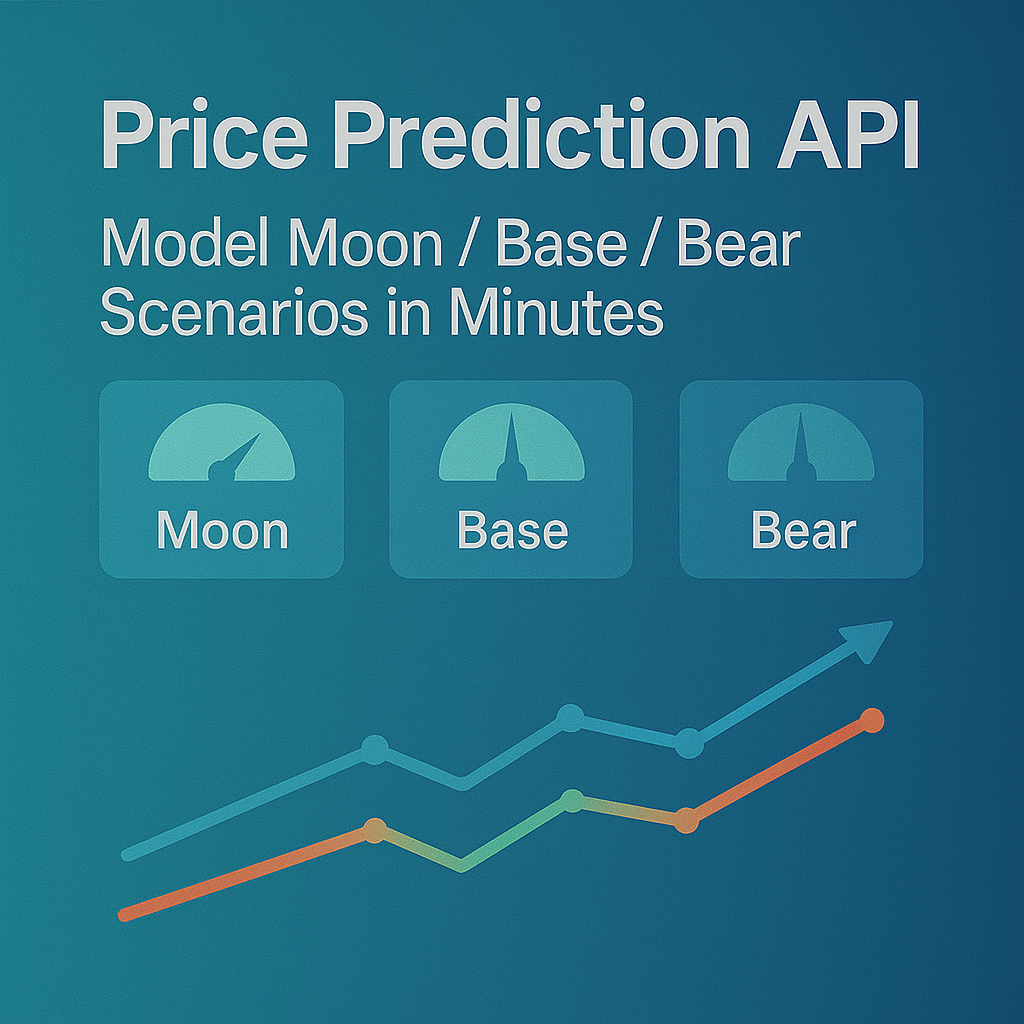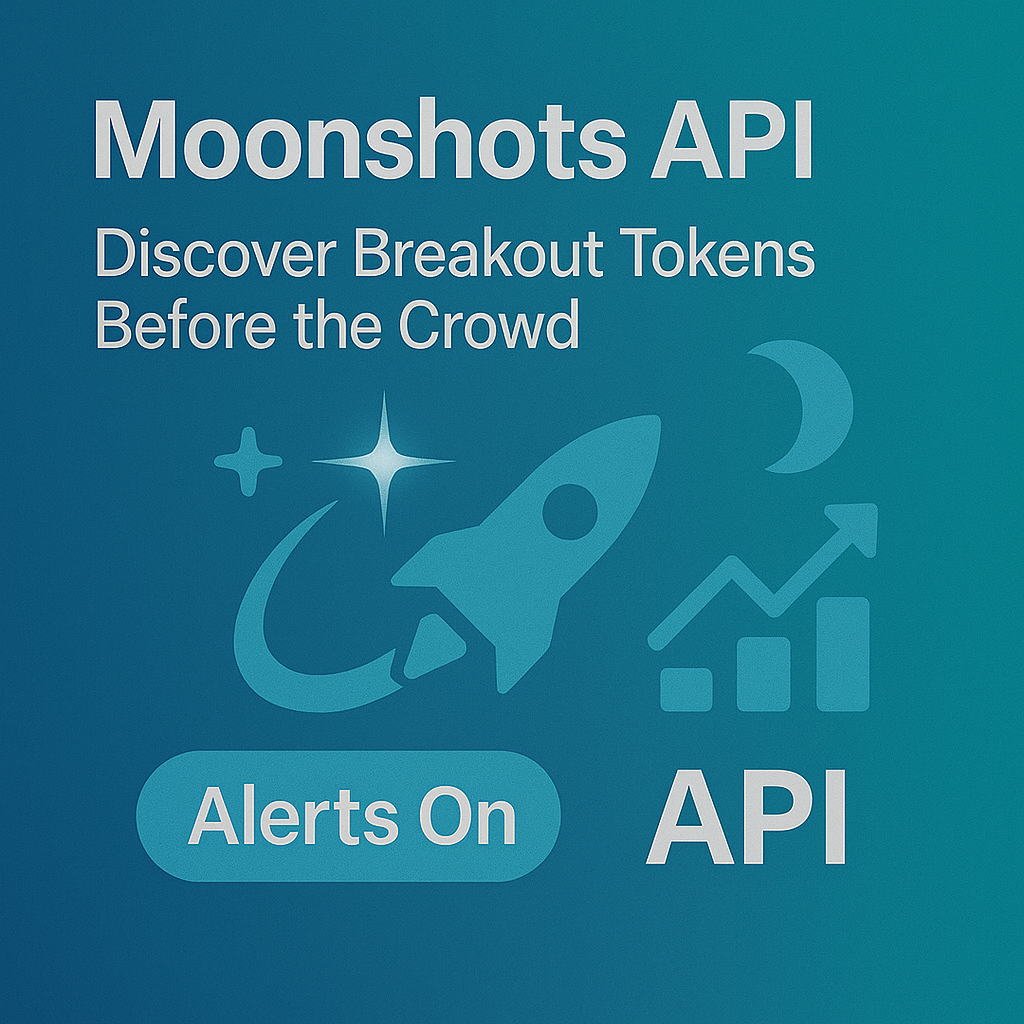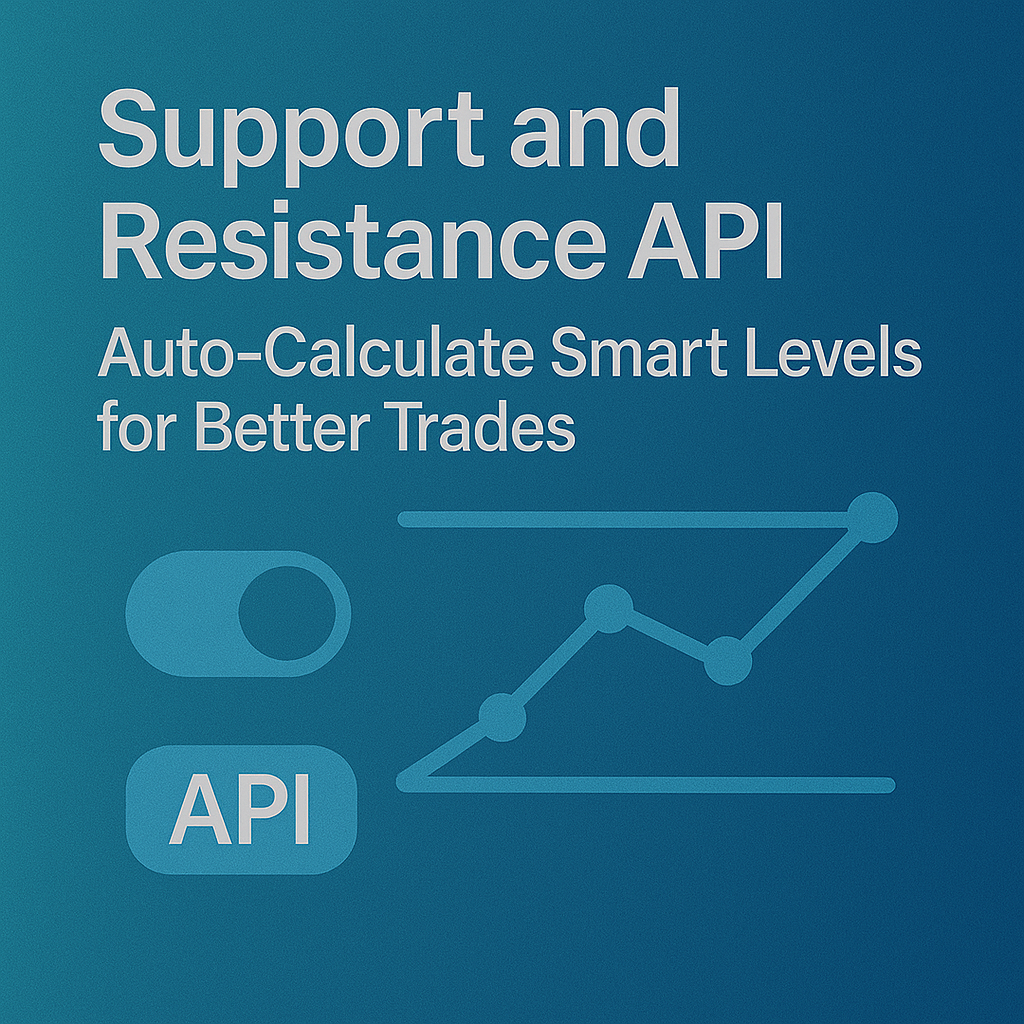Top Crypto Trading Platforms in 2025







%201.svg)
%201.svg)
Big news: We’re cranking up the heat on AI-driven crypto analytics with the launch of the Token Metrics API and our official SDK (Software Development Kit). This isn’t just an upgrade – it's a quantum leap, giving traders, hedge funds, developers, and institutions direct access to cutting-edge market intelligence, trading signals, and predictive analytics.
Crypto markets move fast, and having real-time, AI-powered insights can be the difference between catching the next big trend or getting left behind. Until now, traders and quants have been wrestling with scattered data, delayed reporting, and a lack of truly predictive analytics. Not anymore.
The Token Metrics API delivers 32+ high-performance endpoints packed with powerful AI-driven insights right into your lap, including:
Getting started with the Token Metrics API is simple:
At Token Metrics, we believe data should be decentralized, predictive, and actionable.
The Token Metrics API & SDK bring next-gen AI-powered crypto intelligence to anyone looking to trade smarter, build better, and stay ahead of the curve. With our official SDK, developers can plug these insights into their own trading bots, dashboards, and research tools – no need to reinvent the wheel.
%201.svg)
%201.svg)
The biggest gains in crypto rarely come from the majors. They come from Moonshots—fast-moving tokens with breakout potential. The Moonshots API surfaces these candidates programmatically so you can rank, alert, and act inside your product. In this guide, you’ll call /v2/moonshots, display a high-signal list with TM Grade and Bullish tags, and wire it into bots, dashboards, or screeners in minutes. Start by grabbing your key at Get API Key, then Run Hello-TM and Clone a Template to ship fast.
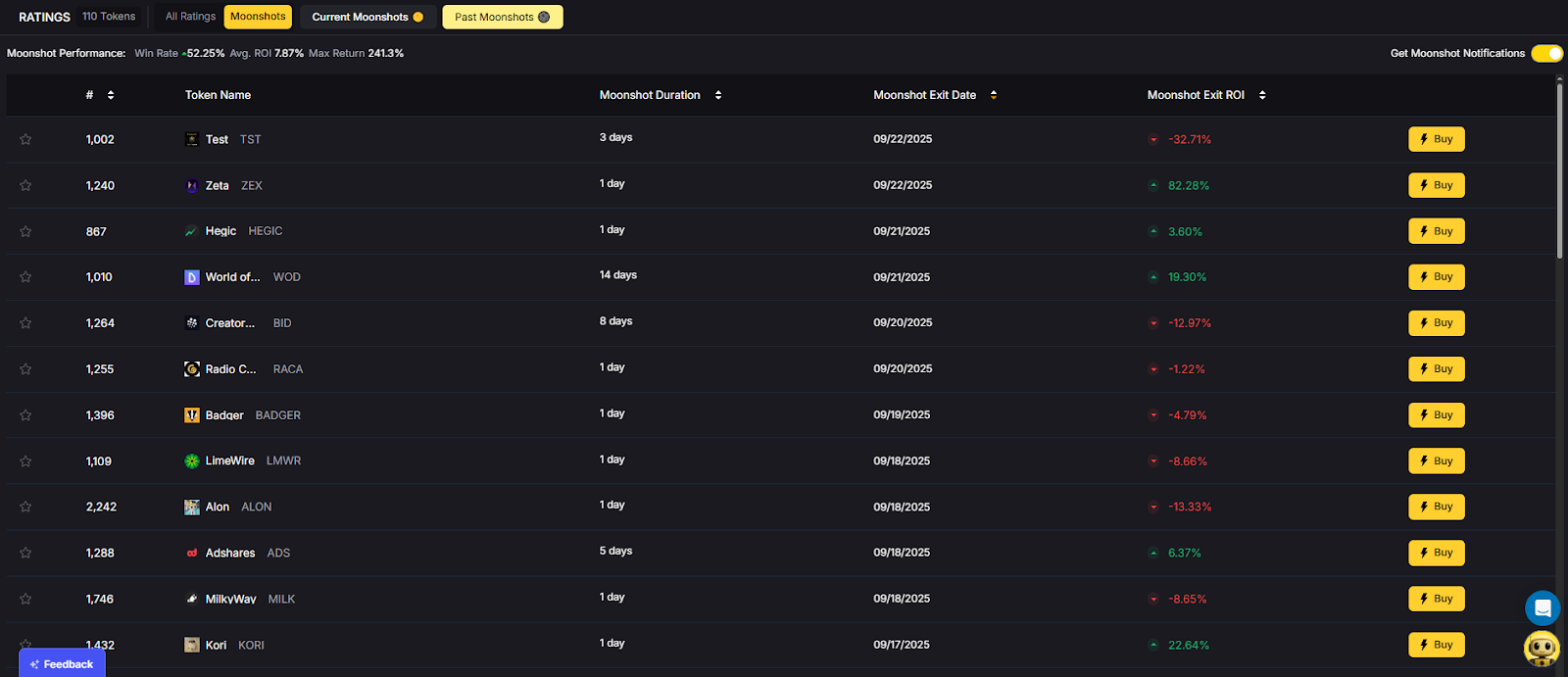
Discovery that converts. Users want more than price tickers—they want a curated, explainable list of high-potential tokens. The moonshots API encapsulates multiple signals into a short list designed for exploration, alerts, and watchlists you can monetize.
Built for builders. The endpoint returns a consistent schema with grade, signal, and context so you can immediately sort, badge, and trigger workflows. With predictable latency and clear filters, you can scale to dashboards, mobile apps, and headless bots without reinventing the discovery pipeline.
The Moonshots API cURL request is right there in the top right of the API Reference. Grab it and start tapping into the potential!
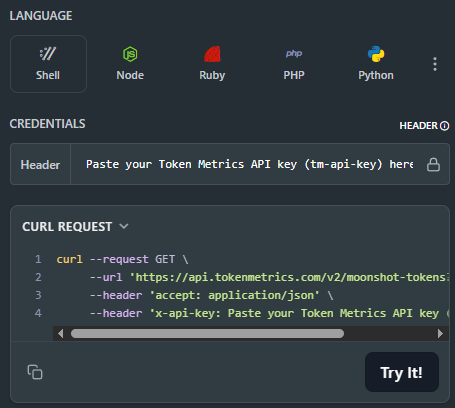
👉 Keep momentum: Get API Key • Run Hello-TM • Clone a Template
Fork a screener or alerting template, plug your key, and deploy. Validate your environment with Hello-TM. When you scale users or need higher limits, compare API plans.
The Moonshots endpoint aggregates a set of evidence—often combining TM Grade, signal state, and momentum/volume context—into a shortlist of breakout candidates. Each row includes a symbol, grade, signal, and timestamp, plus optional reason tags for transparency.
For UX, a common pattern is: headline list → token detail where you render TM Grade (quality), Trading Signals (timing), Support/Resistance (risk placement), Quantmetrics (risk-adjusted performance), and Price Prediction scenarios. This lets users understand why a token was flagged and how to act with risk controls.
Polling vs webhooks. Dashboards typically poll with short-TTL caching. Alerting flows use scheduled jobs or webhooks (where available) to smooth traffic and avoid duplicates. Always make notifications idempotent.
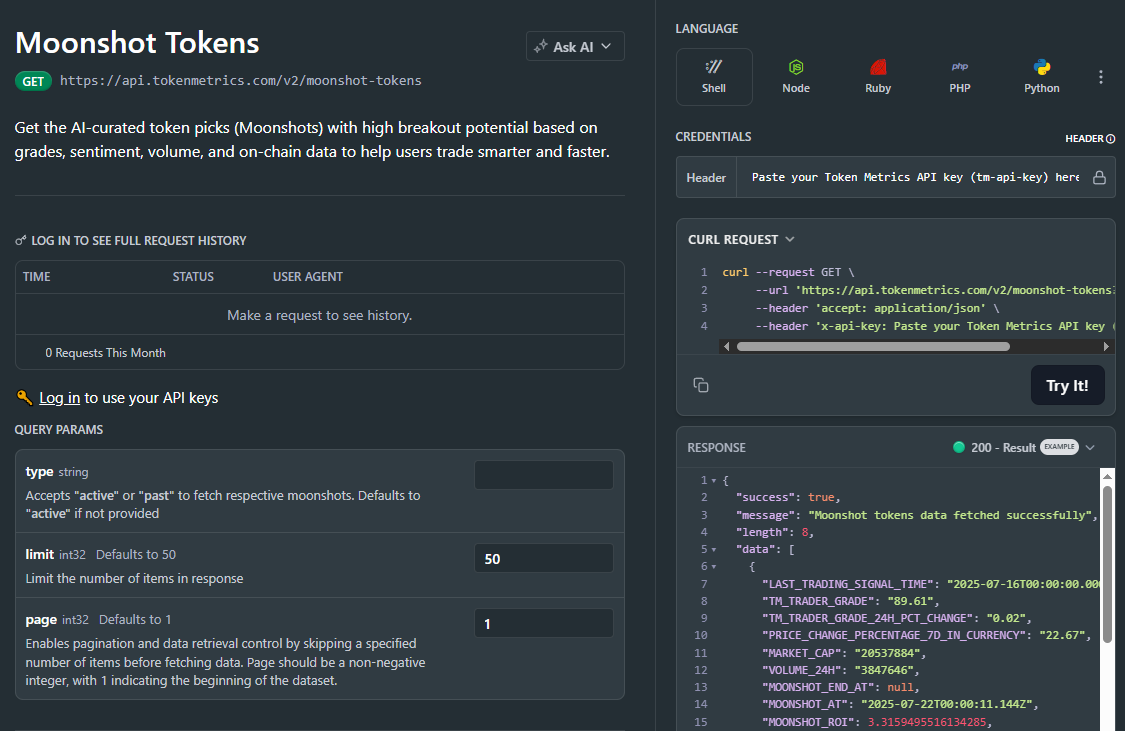
1) What does the Moonshots API return?
A list of breakout candidates with fields such as symbol, tm_grade, signal (often Bullish/Bearish), optional reason tags, and updated_at. Use it to drive discover tabs, alerts, and watchlists.
2) How fresh is the list? What about latency/SLOs?
The endpoint targets predictable latency and timely updates for dashboards and alerts. Use short-TTL caching and queued jobs/webhooks to avoid bursty polling.
3) How do I use Moonshots in a trading workflow?
Common stack: Moonshots for discovery, Trading Signals for timing, Support/Resistance for SL/TP, Quantmetrics for sizing, and Price Prediction for scenario context. Always backtest and paper-trade first.
4) I saw results like “+241%” and a “7.5% average return.” Are these guaranteed?
No. Any historical results are illustrative and not guarantees of future performance. Markets are risky; use risk management and testing.
5) Can I filter the Moonshots list?
Yes—pass parameters like min_grade, signal, and limit (as supported) to tailor to your audience and keep pages fast.
6) Do you provide SDKs or examples?
REST works with JavaScript and Python snippets above. Docs include quickstarts, Postman collections, and templates—start with Run Hello-TM.
7) Pricing, limits, and enterprise SLAs?
Begin free and scale up. See API plans for rate limits and enterprise options.
%201.svg)
%201.svg)
Most traders still draw lines by hand in TradingView. The support and resistance API from Token Metrics auto-calculates clean support and resistance levels from one request, so your dashboard, bot, or alerts can react instantly. In minutes, you’ll call /v2/resistance-support, render actionable levels for any token, and wire them into stops, targets, or notifications. Start by grabbing your key on Get API Key, then Run Hello-TM and Clone a Template to ship a production-ready feature fast.
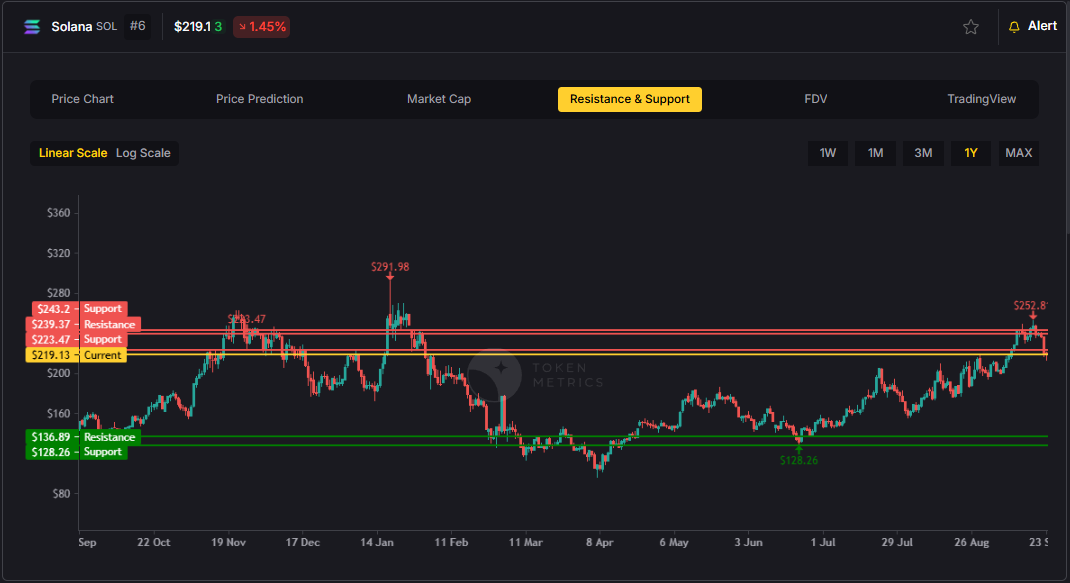
Precision beats guesswork. Hand-drawn lines are subjective and slow. The support and resistance API standardizes levels across assets and timeframes, enabling deterministic stops and take-profits your users (and bots) can trust.
Production-ready by design. A simple REST shape, predictable latency, and clear semantics let you add levels to token pages, automate SL/TP alerts, and build rule-based execution with minimal glue code.
Need the Support and Resistance data? The cURL request for it is in the top right of the API Reference for quick access.
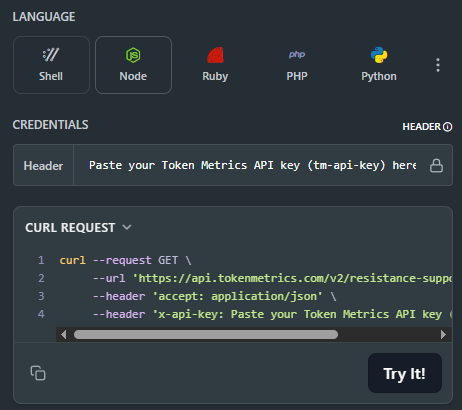
👉 Keep momentum: Get API Key • Run Hello-TM • Clone a Template
Kick off with our quickstarts—fork a bot or dashboard template, plug your key, and deploy. Confirm your environment by Running Hello-TM. When you’re scaling or need webhooks/limits, review API plans.
The Support/Resistance endpoint analyzes recent price structure to produce discrete levels above and below current price, along with strength indicators you can use for priority and styling. Query /v2/resistance-support?symbol=<ASSET>&timeframe=<HORIZON> to receive arrays of level objects and timestamps.
Polling vs webhooks. For dashboards, short-TTL caching and batched fetches keep pages snappy. For bots and alerts, use queued jobs or webhooks (where applicable) to avoid noisy, bursty polling—especially around market opens and major events.
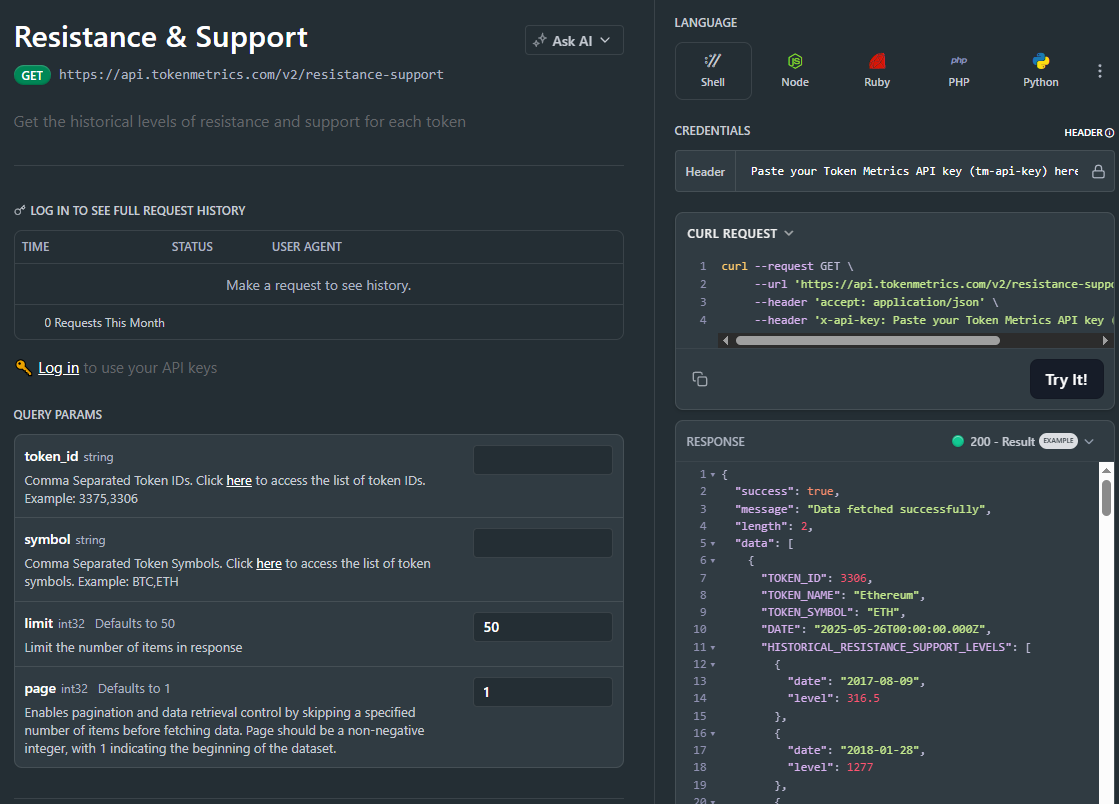
1) What does the Support & Resistance API return?
A JSON payload with arrays of support and resistance levels for a symbol (and optional timeframe), each with a price and strength indicator, plus an update timestamp.
2) How timely are the levels? What are the latency/SLOs?
The endpoint targets predictable latency suitable for dashboards and alerts. Use short-TTL caching for UIs, and queued jobs or webhooks for alerting to smooth traffic.
3) How do I trigger alerts or trades from levels?
Common patterns: alert when price is within X% of a level, touches a level, or breaks beyond with confirmation. Always make downstream actions idempotent and respect rate limits.
4) Can I combine levels with other endpoints?
Yes—pair with /v2/trading-signals for timing, /v2/tm-grade for quality context, and /v2/quantmetrics for risk sizing. This yields a complete decide-plan-execute loop.
5) Which timeframe should I use?
Intraday bots prefer shorter horizons; swing/position dashboards use daily or higher-timeframe levels. Offer a timeframe toggle and cache results per setting.
6) Do you provide SDKs or examples?
Use the REST snippets above (JS/Python). The docs include quickstarts, Postman collections, and templates—start with Run Hello-TM.
7) Pricing, limits, and enterprise SLAs?
Begin free and scale as you grow. See API plans for rate limits and enterprise SLA options.
%201.svg)
%201.svg)
Most traders see price—quants see probabilities. The Quantmetrics API turns raw performance into risk-adjusted stats like Sharpe, Sortino, volatility, drawdown, and CAGR so you can compare tokens objectively and build smarter bots and dashboards. In minutes, you’ll query /v2/quantmetrics, render a clear performance snapshot, and ship a feature that customers trust. Start by grabbing your key at Get API Key, Run Hello-TM to verify your first call, then Clone a Template to go live fast.
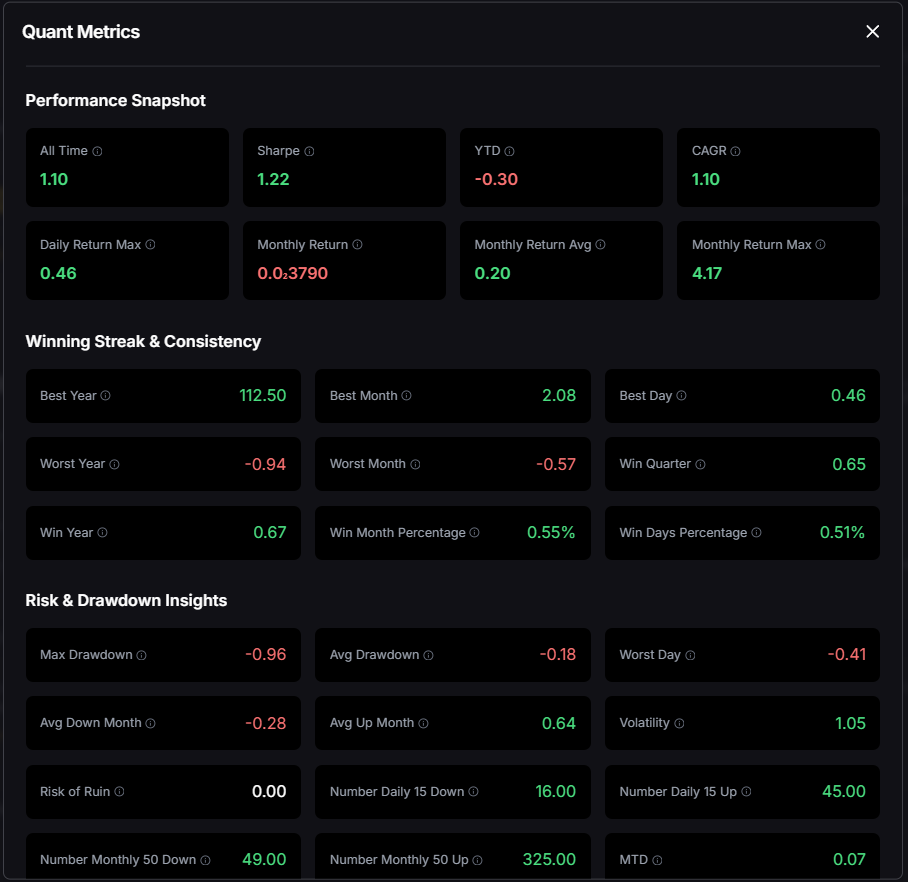
Risk-adjusted truth beats hype. Price alone hides tail risk and whipsaws. Quantmetrics compresses edge, risk, and consistency into metrics that travel across assets and timeframes—so you can rank universes, size positions, and communicate performance like a pro.
Built for dev speed. A clean REST schema, predictable latency, and easy auth mean you can plug Sharpe/Sortino into bots, dashboards, and screeners without maintaining your own analytics pipeline. Pair with caching and batching to serve fast pages at scale.
The Quant Metrics cURL request is located in the top right of the API Reference, allowing you to easily integrate it with your application.
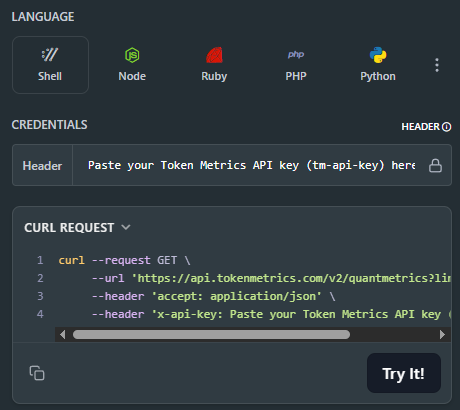
👉 Keep momentum: Get API Key • Run Hello-TM • Clone a Template
Kick off from quickstarts in the docs—fork a dashboard or screener template, plug your key, and deploy in minutes. Validate your environment with Run Hello-TM; when you need more throughput or webhooks, compare API plans.
Quantmetrics computes risk-adjusted performance over a chosen lookback (e.g., 30d, 90d, 1y). You’ll receive a JSON snapshot with core statistics:
Call /v2/quantmetrics?symbol=<ASSET>&window=<LOOKBACK> to fetch the current snapshot. For dashboards spanning many tokens, batch symbols and apply short-TTL caching. If you generate alerts (e.g., “Sharpe crossed 1.5”), run a scheduled job and queue notifications to avoid bursty polling.
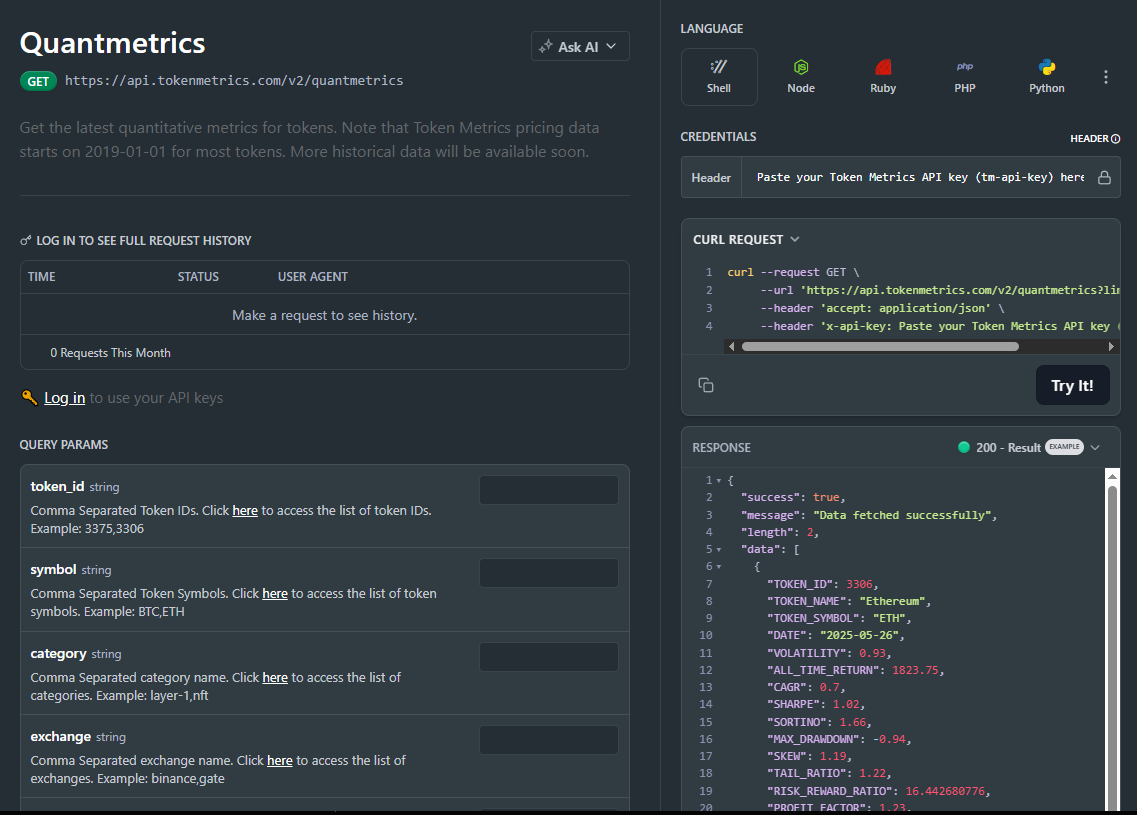
1) What does the Quantmetrics API return?
A JSON snapshot of risk-adjusted metrics (e.g., Sharpe, Sortino, volatility, max drawdown, CAGR) for a symbol and lookback window—ideal for ranking, sizing, and dashboards.
2) How fresh are the stats? What about latency/SLOs?
Responses are engineered for predictable latency. For heavy UI usage, add short-TTL caching and batch requests; for alerts, use scheduled jobs or webhooks where available.
3) Can I use Quantmetrics to size positions in a live bot?
Yes—many quants size inversely to volatility or require Sharpe ≥ X to trade. Always backtest and paper-trade before going live; past results are illustrative, not guarantees.
4) Which lookback window should I choose?
Short windows (30–90d) adapt faster but are noisier; longer windows (6–12m) are steadier but slower to react. Offer users a toggle and cache each window.
5) Do you provide SDKs or examples?
REST is straightforward (JS/Python above). Docs include quickstarts, Postman collections, and templates—start with Run Hello-TM.
6) Polling vs webhooks for quant alerts?
Dashboards usually use cached polling. For threshold alerts (e.g., Sharpe crosses 1.0), run scheduled jobs and queue notifications to keep usage smooth and idempotent.
7) Pricing, limits, and enterprise SLAs?
Begin free and scale up. See API plans for rate limits and enterprise SLA options.

%201.svg)
%201.svg)
APIs are the invisible connectors that let software talk to software. Whether you book a flight, check a crypto price, or ask an AI agent to summarize a document, APIs are likely working behind the scenes. This guide breaks down what an API is, how it works, common types and use cases, and practical steps for research and integration.
An API, or application programming interface, is a defined set of rules and data structures that lets one software component request services or data from another. Think of an API as a contract: the provider exposes endpoints and data formats, and the consumer uses those endpoints to perform actions or retrieve information. This abstraction hides implementation details, enabling interoperability and composability across systems.
At its core, an API specifies:
APIs accelerate development by allowing teams to reuse services instead of rebuilding functionality. They also enable ecosystems: marketplaces, integrations, and data sharing across organizations.
APIs are implemented over protocols and architectural styles. The most common is REST (Representational State Transfer), which uses HTTP verbs (GET, POST, PUT, DELETE) and URIs to model resources. Alternatives like GraphQL let clients request specific data shapes, which can reduce over- and under-fetching in complex applications.
Key components to understand:
Beyond REST and GraphQL, there are webhooks (server-to-server push notifications), gRPC for high-performance RPC-style communication, and socket-based APIs for real-time streams. The choice of protocol affects latency, throughput, and developer ergonomics.
APIs come in several flavors depending on visibility and purpose:
Common use cases illustrate how APIs deliver value:
For example, crypto applications rely heavily on exchange and on-chain data APIs to aggregate prices, monitor wallets, and execute analytics at scale. Evaluating latency, historical coverage, and data quality is critical when selecting a provider for time-series or transactional data.
Developers use APIs to compose microservices, integrate third-party functionality, and automate workflows. For AI systems, APIs are essential both to access model inference and to fetch context data that models use as inputs.
Practical patterns include:
When integrating APIs for analytics or AI, consider data consistency, schema evolution, and error semantics. Tools and platforms can monitor usage, surface anomalies, and provide fallbacks for degraded endpoints.
For researchers and teams assessing providers, structured evaluations help: compare SLA terms, data freshness, query flexibility, cost per request, and developer experience. Platforms that combine market data with AI-driven signals can accelerate exploratory analysis; for example, Token Metrics provides AI-backed research and ratings that teams often use to prioritize datasets and hypothesis testing.
Build Smarter Crypto Apps & AI Agents with Token Metrics
Token Metrics provides real-time prices, trading signals, and on-chain insights all from one powerful API. Grab a Free API Key
Q1: What is the difference between an API and a library?
An API defines a set of rules and endpoints for interaction between systems, often over a network. A library is a local collection of functions and classes that an application links to at runtime. Libraries run in-process; APIs often run across processes or machines.
Q2: How should APIs be secured?
Common security measures include authentication (API keys, OAuth), encryption (TLS), input validation, rate limiting, and monitoring for anomalous patterns. Security practices should match the sensitivity of data and regulatory requirements.
Q3: When to choose REST over GraphQL?
REST is simple and well-suited to resource-based designs and caching. GraphQL is useful when clients need precise control over returned fields and want to minimize round trips. The right choice depends on client needs, caching strategy, and team expertise.
Q4: What factors affect API pricing?
Pricing typically depends on request volume, data granularity, retention of historical data, and premium features such as websockets, SLAs, or enriched analytics. Evaluate costs under realistic usage patterns and spikes.
Q5: How do I evaluate and integrate a new API?
Start by reading docs, testing sandbox endpoints, and estimating request volumes. Validate data formats, authentication flows, and edge cases (rate limits, errors). Prototype with small workloads before committing to production usage.
Q6: Do APIs involve legal or compliance considerations?
APIs that handle personal data, financial transactions, or regulated assets may be subject to privacy laws, financial regulations, or contractual obligations. Assess compliance requirements, data residency, and logging needs early in the design process.
This article is for educational purposes only and does not constitute investment, legal, or professional advice. Information contained here is neutral and analytical; always perform independent research and consult qualified professionals for decisions involving legal or financial risk.

%201.svg)
%201.svg)
APIs (Application Programming Interfaces) are the invisible wiring that lets modern software communicate. From mobile apps fetching data to AI agents orchestrating workflows, APIs enable systems to request services, exchange structured data, and extend functionality without exposing internal implementation. This article unpacks what an API is, how different API styles operate, where they’re used (including crypto and AI contexts), and practical approaches to evaluate, integrate, and secure them.
An API is a set of rules and conventions that allows one software component to interact with another. At its simplest, an API defines:
Think of an API as a contract: the provider promises certain behaviors and data shapes, and the consumer agrees to use the API according to those rules. That contract enables modular design, reusability, and language-agnostic integration.
APIs use protocols and conventions to carry requests and responses. The most common patterns include:
Choosing an architecture depends on latency needs, payload sizes, versioning strategy, and developer ergonomics. For instance, GraphQL can simplify complex frontend queries, while REST remains straightforward for simple resource CRUD operations.
APIs power an enormous variety of use cases across industries. Representative examples include:
In the crypto ecosystem, APIs are fundamental: explorers, node providers, exchanges, and analytics platforms expose endpoints for price feeds, order books, trade history, wallet balances, and on-chain events. AI-driven research tools use APIs to combine market data, on-chain signals, and model outputs into research workflows and agents.
Adopting an API requires both technical and operational considerations. A pragmatic evaluation process includes:
When integrating multiple APIs—such as combining market data with model inference—consider a middleware layer that normalizes data shapes, caches frequent responses, and orchestrates calls to minimize latency and cost.
Build Smarter Crypto Apps & AI Agents with Token Metrics
Token Metrics provides real-time prices, trading signals, and on-chain insights all from one powerful API. Grab a Free API Key
An API is a broader concept that defines interfaces for software interaction. A web service is a type of API that operates over network protocols such as HTTP. In practice, REST and GraphQL are web service styles used to implement APIs.
Public APIs can be safe if they follow security best practices: HTTPS everywhere, proper authentication, input validation, and rate limiting. Consumers should validate responses, handle errors, and avoid exposing credentials in client-side code.
API keys are simple tokens that identify a client application and are often used for server-to-server interactions. OAuth is a delegated authorization framework that allows users to grant limited access to their accounts without sharing credentials—common for user-facing integrations.
Rate limiting constrains how many requests a client can make in a time window. It prevents abuse, protects backend resources, and ensures fair usage. Clients should implement retries with exponential backoff and caching to stay within limits.
Choose GraphQL when clients need flexible, precise queries that fetch nested or disparate fields in a single request. REST can be simpler for straightforward resource CRUD and when predictable caching semantics are required.
Yes. Real-time patterns include WebSockets, Server-Sent Events (SSE), and streaming APIs. Some platforms also provide push notifications or webhooks to deliver near-instant updates to subscribers.
Common strategies include using version numbers in the URL (e.g., /v1/) or via headers. Maintain backward compatibility, communicate deprecation timelines, and provide migration guides to minimize friction for integrators.
Track uptime, latency percentiles, error rates, and throughput. Instrument retries, logging of failed requests, and alerts for sustained degradation. Observability helps diagnose issues and communicate with API providers when needed.
Disclaimer: This article is for educational and informational purposes only. It explains technical concepts related to APIs and integration practices and does not provide financial, investment, or regulatory advice. Always evaluate tools and services according to your own requirements and compliance needs.

%201.svg)
%201.svg)
APIs — application programming interfaces — are the invisible glue that lets software talk to software. Whether you're building a dashboard, feeding data into an AI model, or fetching market prices for analytics, understanding what an API is and how it works is essential to designing reliable systems. This guide explains APIs in plain language, shows how they’re used in crypto and AI, and outlines practical steps for safe, scalable integration.
An API (application programming interface) is a defined set of rules and endpoints that lets one software program request and exchange data or functionality with another. Think of it as a contract: the provider defines what inputs it accepts and what output it returns, and the consumer follows that contract to integrate services reliably.
Common API types:
At a technical level, using an API involves sending a request to an endpoint and interpreting the response. Key components include:
Understanding these elements helps teams design error handling, retry logic, and monitoring so integrations behave predictably in production.
APIs enable many building blocks in crypto and AI ecosystems. Examples include:
When integrating APIs for data-driven systems, consider latency, data provenance, and consistency. For research and model inputs, services that combine price data with on-chain metrics and signals can reduce the time it takes to assemble reliable datasets. For teams exploring such aggregations, Token Metrics provides an example of an AI-driven analytics platform that synthesizes multiple data sources for research workflows.
Secure, maintainable APIs follow established practices that protect data and reduce operational risk:
Following these practices helps teams scale API usage without sacrificing reliability or security.
Build Smarter Crypto Apps & AI Agents with Token Metrics
Token Metrics provides real-time prices, trading signals, and on-chain insights all from one powerful API. Grab a Free API Key
An API is a set of rules that enables software components to interact. It’s useful because it abstracts complexity, standardizes data exchange, and enables modular development across systems and teams.
Choose based on access patterns: REST is simple and widely supported; GraphQL excels when clients need flexible queries and fewer round trips; streaming (WebSocket) is best for low-latency, continuous updates. Consider caching, complexity, and tooling support.
Store secrets in secure vaults or environment variables, avoid hardcoding them in source code, rotate keys periodically, and apply principle of least privilege to limit access scopes.
Rate limits restrict how many requests a client can make in a time window. Handle them by respecting limits, implementing exponential backoff for retries, caching responses, and batching requests where possible.
Assess documentation quality, uptime SLAs, authentication methods, data freshness, cost model, and community or support channels. Test with realistic workloads and review security practices and versioning policies.
Yes. AI agents often call APIs for data ingestion, model inference, or action execution. Reliable APIs for feature data, model serving, and orchestration are key to building robust AI workflows.
This article is for educational and informational purposes only. It does not constitute financial, investment, legal, or professional advice. Evaluate APIs and data sources independently and consider security and compliance requirements specific to your use case.

%201.svg)
%201.svg)
APIs power modern software by acting as intermediaries that let different programs communicate. Whether you use a weather app, sign in with a social account, or combine data sources for analysis, APIs are the plumbing behind those interactions. This guide breaks down what an API is, how it works, common types and use cases, plus practical steps to evaluate and use APIs responsibly.
An application programming interface (API) is a contract between two software components. It specifies the methods, inputs, outputs, and error handling that allow one service to use another’s functionality or data without needing to know its internal implementation. Think of an API as a well-documented door: the requester knocks with a specific format, and the server replies according to agreed rules.
APIs matter because they:
At a technical level, an API involves several elements that define reliable communication:
Most web APIs use HTTP as a transport; RESTful APIs map CRUD operations to HTTP verbs, while alternatives like GraphQL let clients request exactly the data they need. The right style depends on use cases and performance trade-offs.
APIs appear across many layers of software and business models. Common categories include:
Practical examples: a mobile app calling a backend to fetch user profiles, an analytics pipeline ingesting a third-party data API, or a serverless function invoking a payment API to process transactions.
Designing and consuming APIs effectively requires both technical and governance considerations:
When evaluating an API to integrate, consider documentation quality, SLAs, data freshness, error handling patterns, and cost model. For data-driven workflows and AI systems, consistency of schemas and latency characteristics are critical.
APIs are foundational for AI and data research because they provide structured, automatable access to data and models. Teams often combine multiple APIs—data feeds, enrichment services, feature stores—to assemble training datasets or live inference pipelines. Important considerations include freshness, normalization, rate limits, and licensing of data.
AI-driven research platforms can simplify integration by aggregating multiple sources and offering standardized endpoints. For example, Token Metrics provides AI-powered analysis that ingests diverse signals via APIs to support research workflows and model inputs.
Discover Crypto Gems with Token Metrics AI
Token Metrics uses AI-powered analysis to help you uncover profitable opportunities in the crypto market. Get Started For Free
API stands for Application Programming Interface. It is a set of rules and definitions that lets software components communicate by exposing specific operations and data formats.
A web API is accessed over a network (typically HTTP) and provides remote functionality or data. A library or SDK is code included directly in an application. APIs enable decoupled services and cross-platform access; libraries are local dependencies.
REST is an architectural style using HTTP verbs and resource URIs. GraphQL lets clients specify exactly which fields they need in a single query. gRPC is a high-performance RPC framework using protocol buffers and is suited for internal microservice communication with strict performance needs.
Common methods include API keys, OAuth 2.0 for delegated access, and JWTs for stateless tokens. Choose an approach that matches security requirements and user interaction patterns; always use TLS to protect credentials in transit.
Failures include rate-limit rejections, transient network errors, schema changes, and authentication failures. Implement retries with exponential backoff for transient errors, validate responses, and monitor for schema or semantic changes.
Yes. Polling HTTP APIs at short intervals can approximate near-real-time, but push-based models (webhooks, streaming APIs, WebSockets, or event streams) are often more efficient and lower latency for real-time needs.
Evaluate documentation, uptime history, data freshness, pricing, rate limits, privacy and licensing, and community support. For data or AI integrations, prioritize consistent schemas, sandbox access, and clear SLAs.
Start with principles like consistent resource naming, strong documentation (OpenAPI/Swagger), automated testing, and security by design. Study public APIs from major platforms and use tools that validate contracts and simulate client behavior.
This article is for educational and informational purposes only. It does not constitute investment advice, financial recommendations, or endorsements. Readers should perform independent research and consult qualified professionals where appropriate.

%201.svg)
%201.svg)
APIs — short for application programming interfaces — are the invisible connectors that let software systems communicate, share data, and build layered services. Whether you’re building a mobile app, integrating a payment gateway, or connecting an AI model to live data, understanding what an API does and how it behaves is essential for modern product and research teams.
An API is a defined set of rules, protocols, and tools that lets one software component request services or data from another. Conceptually, an API is an interface: it exposes specific functions and data structures while hiding internal implementation details. That separation supports modular design, reusability, and clearer contracts between teams or systems.
Common API categories include:
At a high level, interaction with an API follows a request-response model. A client sends a request to an endpoint with a method (e.g., GET, POST), optional headers, and a payload. The server validates the request, performs logic or database operations, and returns a structured response. Key concepts include:
Advanced setups add caching, pagination, versioning, and webhook callbacks for asynchronous events. GraphQL, in contrast to REST, enables clients to request exactly the fields they need, reducing over- and under-fetching in many scenarios.
APIs are foundational in nearly every digital industry. Example use cases include:
In AI and research workflows, APIs let teams feed models with curated live data, automate labeling pipelines, or orchestrate multi-step agent behavior. In crypto, programmatic access to market and on-chain signals enables analytics, monitoring, and application integration without manual data pulls.
Designing and consuming APIs requires intentional choices: clear documentation, predictable error handling, and explicit versioning reduce integration friction. Security measures should include:
When integrating third-party APIs—especially for sensitive flows like payments or identity—run scenario analyses for failure modes, data consistency, and latency. For AI-driven systems, consider auditability and reproducibility of inputs and outputs to support troubleshooting and model governance.
Build Smarter Crypto Apps & AI Agents with Token Metrics
Token Metrics provides real-time prices, trading signals, and on-chain insights all from one powerful API. Grab a Free API Key
Q: What is the simplest way to think about an API?
A: Think of an API as a waiter in a restaurant: it takes a client’s request, communicates with the kitchen (the server), and delivers a structured response. The waiter abstracts the kitchen’s complexity.
Q: Which API styles should I consider for a new project?
A: Common choices are REST for broad compatibility, GraphQL for flexible queries, and gRPC for high-performance microservices. Selection depends on client needs, payload shape, and latency requirements.
Q: What authentication methods are typical?
A: Typical methods include API keys for simple access, OAuth2 for delegated access, JWT tokens for stateless auth, and mutual TLS for high-security environments.
Q: What should teams monitor to reduce API risk?
A: Monitor for excessive request volumes, suspicious endpoints, unusual payloads, and repeated failed auth attempts. Regularly review access scopes and rotate credentials.
Q: How do AI systems typically use APIs?
A: AI systems use APIs to fetch data for training or inference, send model inputs to inference endpoints, and collect telemetry. Well-documented APIs support reproducible experiments and production deployment.
This article is for educational and informational purposes only. It does not provide financial, legal, or professional advice. Evaluate third-party services carefully and consider security, compliance, and operational requirements before integration.

%201.svg)
%201.svg)
APIs (application programming interfaces) are the invisible connectors that let software systems talk to each other. Whether you open a weather app, sign in with a social account, or call a machine-learning model, an API is usually orchestrating the data exchange behind the scenes. This guide explains what an API is, how APIs work, common types and use cases, and practical frameworks to evaluate or integrate APIs into projects.
An API is a set of rules, protocols, and tools that defines how two software components communicate. At its simplest, an API specifies the inputs a system accepts, the outputs it returns, and the behavior in between. APIs abstract internal implementation details so developers can reuse capabilities without understanding the underlying codebase.
Key concepts:
Most modern APIs use HTTP as the transport protocol and follow architectural styles such as REST or GraphQL. A typical interaction looks like this:
APIs also expose documentation and machine-readable specifications (OpenAPI/Swagger, RAML) that describe available endpoints, parameters, data models, and expected responses. Tools can generate client libraries and interactive docs from these specs, accelerating integration.
APIs serve different purposes depending on design and context:
Use cases span the product lifecycle: integrating third-party services, composing microservices, extending platforms, or enabling AI models to fetch and write data programmatically.
When selecting or integrating an API, apply a simple checklist to reduce technical risk and operational friction:
Operationally, start with a sandbox key and integrate incrementally: mock responses in early stages, implement retry/backoff and circuit breakers, and monitor usage and costs in production.
Build Smarter Crypto Apps & AI Agents with Token Metrics
Token Metrics provides real-time prices, trading signals, and on-chain insights all from one powerful API. Grab a Free API Key
REST organizes resources as endpoints and often returns fixed data shapes per endpoint. GraphQL exposes a single endpoint where clients request the exact fields they need. REST is simple and cache-friendly; GraphQL reduces over-fetching but can require more server-side control and caching strategies.
API keys are simple tokens issued to identify a client and are easy to use for server-to-server interactions. OAuth provides delegated access where a user can authorize a third-party app to act on their behalf without sharing credentials; it's essential for user-consent flows.
Yes. OpenAPI (formerly Swagger) is widely used for REST APIs and supports automated client generation and interactive documentation. GraphQL has its own schema specification and introspection capabilities. Adopting standards improves developer experience significantly.
Common practices include strong authentication, TLS encryption, input validation, explicit authorization, rate limiting, and logging. For sensitive data, consider data minimization, field-level encryption, and strict access controls.
AI models can call APIs to fetch external context, enrich inputs, or persist outputs. Examples include retrieving live market data, fetching user profiles, or invoking specialized ML inference services. Manage latency, cost, and error handling when chaining many external calls in a pipeline.
This article is for educational and informational purposes only. It does not constitute professional, legal, or financial advice. Evaluate any API, provider, or integration according to your own technical, legal, and security requirements before use.

%201.svg)
%201.svg)
APIs from Google power a huge portion of modern applications, from location-aware mobile apps to automated data workflows in the cloud. Understanding how Google API endpoints, authentication, quotas, and client libraries fit together helps developers build reliable, maintainable integrations that scale. This guide breaks down the most practical aspects of working with Google APIs and highlights research and AI tools that can streamline development.
"Google API" is an umbrella term for a wide range of services offered by Google, including but not limited to Google Cloud APIs (Compute, Storage, BigQuery), Maps and Places, OAuth 2.0 identity, Drive, Sheets, and machine learning APIs like Vision and Translation. Each service exposes RESTful endpoints and often provides SDKs in multiple languages (Node.js, Python, Java, Go, and more).
Key dimensions to evaluate when selecting a Google API:
Popular categories and what developers commonly use them for:
Choosing the right API often starts with mapping product requirements to the available endpoints. For example, if you need user authentication and access to Google Drive files, combine OAuth 2.0 with the Drive API rather than inventing a custom flow.
Follow these practical steps to reduce friction and improve reliability:
These patterns reduce operational surprises and make integrations more maintainable over time.
Security and quota constraints often shape architecture decisions:
Secure-by-design implementations and proactive quota management reduce operational risk when moving from prototype to production.
Combining Google APIs with AI tooling unlocks new workflows: use Vision API to extract entities from images, then store structured results in BigQuery for analytics; call Translation or Natural Language for content normalization before indexing. When experimenting with AI-driven pipelines, maintain traceability between raw inputs and transformed outputs to support auditing and debugging.
AI-driven research platforms like Token Metrics can help developers prototype analytics and compare signal sources by aggregating on-chain and market datasets; such tools may inform how you prioritize data ingestion and model inputs when building composite systems that include external data alongside Google APIs.
Build Smarter Crypto Apps & AI Agents with Token Metrics
Token Metrics provides real-time prices, trading signals, and on-chain insights all from one powerful API. Grab a Free API Key
Google APIs are a collection of RESTful services and SDKs that grant programmatic access to Google products and cloud services. They differ in scope and SLAs from third-party APIs by integrating with Google Cloud's IAM, billing, and monitoring ecosystems.
Use OAuth 2.0 for user-level access where users must grant permission. For server-to-server calls, use service accounts with short-lived tokens. API keys are acceptable for public, limited-scope requests like simple Maps access but carry higher security risk if exposed.
Monitor quotas in Google Cloud Console under the "IAM & Admin" and "APIs & Services" sections. If you need more capacity, submit a quota increase request with usage patterns and justification; Google evaluates requests based on scope and safety.
Cost depends on API type and usage volume. Use the Google Cloud Pricing Calculator for services like BigQuery or Cloud Storage, and review per-request pricing for Maps and Vision APIs. Track costs via billing reports and set alerts to avoid surprises.
Client libraries are not strictly necessary, but they simplify authentication flows, retries, and response parsing. If you need maximum control or a minimal runtime, you can call REST endpoints directly with standard HTTP libraries.
This article is educational and technical in nature. It does not provide financial, legal, or investment advice. Evaluate APIs and third-party services against your own technical, security, and compliance requirements before use.

%201.svg)
%201.svg)
APIs are the connective tissue of modern software. As organizations expose more endpoints to partners, internal teams and third-party developers, effective api management becomes a competitive and operational imperative. This article breaks down practical frameworks, governance guardrails, and monitoring strategies that help teams scale APIs securely and reliably without sacrificing developer velocity.
API management is the set of practices, tools and processes that enable teams to design, publish, secure, monitor and monetize application programming interfaces. At its core it addresses three recurring challenges: consistent access control, predictable performance, and discoverability for developers. Well-managed APIs reduce friction for consumers, decrease operational incidents, and support governance priorities such as compliance and data protection.
Think of api management as a lifecycle discipline: from design and documentation to runtime enforcement and iterative refinement. Organizations that treat APIs as products—measuring adoption, latency, error rates, and business outcomes—are better positioned to scale integrations without accumulating technical debt.
Security and governance are non-negotiable for production APIs. Implement a layered approach:
Combining automated policy enforcement at an API gateway with a governance framework (ownerable APIs, review gates, and versioning rules) ensures changes are controlled without slowing legitimate feature delivery.
Developer experience (DX) determines adoption. Treat APIs as products by providing clear documentation, SDKs and a self-service developer portal. Key practices include:
Metrics to track DX include signups, first successful call time, and repeat usage per key. These are leading indicators of whether an API is fulfilling its product intent.
Operational visibility is essential for api management. Implement monitoring at multiple layers—gateway, service, and database—to triangulate causes when issues occur. Core telemetry includes:
Observability practices—distributed tracing, structured logs, and context propagation—help teams move from alert fatigue to actionable incident response. Build runbooks that map common alerts to remediation steps and owners.
Adopt an incremental roadmap rather than a big-bang rollout. A pragmatic sequence looks like:
Choose tools that match team maturity: managed API platforms accelerate setup for companies lacking infra resources, while open-source gateways provide control for those with specialized needs. Evaluate vendors on extensibility, observability integrations, and policy-as-code support to avoid lock-in.
Build Smarter Crypto Apps & AI Agents with Token Metrics
Token Metrics provides real-time prices, trading signals, and on-chain insights all from one powerful API. Grab a Free API Key
API management encompasses the processes and tools required to publish, secure, monitor, and monetize APIs. It matters because it enables predictable, governed access to services while maintaining developer productivity and operational reliability.
Common components include an API gateway (auth, routing, rate limiting), developer portal (docs, keys), analytics and monitoring systems (metrics, traces), and lifecycle tooling (design, versioning, CI/CD integrations).
Implement defense-in-depth: centralized authentication, token validation, input schema checks, rate limits, and continuous auditing. Shift security left by validating contracts and scanning specs before deployment.
Track latency percentiles, error rates, traffic patterns, and consumer-specific usage. Pair operational metrics with business KPIs (e.g., API-driven signups) to prioritize work that affects outcomes.
Use explicit versioning, deprecation windows, and dual-running strategies where consumers migrate incrementally. Communicate changes via the developer portal and automated notifications tied to API keys.
Introduce a gateway early when multiple consumers, partners, or internal teams rely on APIs. A gateway centralizes cross-cutting concerns and reduces duplicated security and routing logic.
This article is for educational and informational purposes only. It provides neutral, analytical information about api management practices and tools and does not constitute professional or investment advice.

%201.svg)
%201.svg)
APIs are the connective tissue of modern software: they expose functionality, move data, and enable integrations across services, devices, and platforms. A well-designed web API shapes developer experience, system resilience, and operational cost. This article breaks down core concepts, common architectures, security and observability patterns, and practical steps to build and maintain reliable web APIs without assuming a specific platform or vendor.
A web API (Application Programming Interface) is an HTTP-accessible interface that lets clients interact with server-side functionality. APIs can return JSON, XML, or other formats and typically define a contract of endpoints, parameters, authentication requirements, and expected responses. They matter because they enable modularity: front-ends, mobile apps, third-party integrations, and automation tools can all reuse the same backend logic.
When evaluating or designing an API, consider the consumer experience: predictable endpoints, clear error messages, consistent versioning, and comprehensive documentation reduce onboarding friction for integrators. Think of an API as a public product: its usability directly impacts adoption and maintenance burden.
There are several architectural approaches to web APIs. RESTful (resource-based) design emphasizes nouns and predictable HTTP verbs. GraphQL centralizes query flexibility into a single endpoint and lets clients request only the fields they need. gRPC is used for low-latency, binary RPC between services.
Key design practices:
Choose the pattern that aligns with your performance, flexibility, and developer ergonomics goals, and make that decision explicit in onboarding docs.
Security must be built into an API from day one. Common controls include TLS for transport, OAuth 2.0 / OpenID Connect for delegated authorization, API keys for service-to-service access, and fine-grained scopes for least-privilege access. Input validation, output encoding, and strict CORS policies guard against common injection and cross-origin attacks.
Operational protections such as rate limiting, quotas, and circuit breakers help preserve availability if a client misbehaves or a downstream dependency degrades. Design your error responses to be informative to developers but avoid leaking internal implementation details. Centralized authentication and centralized secrets management (vaults, KMS) reduce duplication and surface area for compromise.
Performance considerations span latency, throughput, and resource efficiency. Use caching (HTTP cache headers, CDN, or in-memory caches) to reduce load on origin services. Employ pagination, partial responses, and batch endpoints to avoid overfetching. Instrumentation is essential: traces, metrics, and logs help correlate symptoms, identify bottlenecks, and measure SLAs.
Testing should be layered: unit tests for business logic, contract tests against API schemas, integration tests for end-to-end behavior, and load tests that emulate real-world usage. Observability tools and APMs provide continuous insight; AI-driven analytics platforms such as Token Metrics can help surface unusual usage patterns and prioritize performance fixes based on impact.
Build Smarter Crypto Apps & AI Agents with Token Metrics
Token Metrics provides real-time prices, trading signals, and on-chain insights all from one powerful API. Grab a Free API Key
REST exposes multiple endpoints that represent resources and rely on HTTP verbs for operations. It is simple and maps well to HTTP semantics. GraphQL exposes a single endpoint where clients request precisely the fields they need, which reduces overfetching and can simplify mobile consumption. GraphQL adds complexity in query planning and caching; choose based on client needs and team expertise.
Prefer backward-compatible changes over breaking changes. Use semantic versioning for major releases, and consider header-based versioning or URI version prefixes when breaking changes are unavoidable. Maintain deprecation schedules and communicate timelines in documentation and response headers so clients can migrate predictably.
OAuth 2.0 and OpenID Connect are standard for delegated access and single-sign-on. For machine-to-machine communication, use short-lived tokens issued by a trusted authorization server. API keys can be simple to implement but should be scoped, rotated regularly, and never embedded in public clients without additional protections.
Implement synthetic monitoring for critical endpoints, collect real-user metrics (latency percentiles, error rates), and instrument distributed tracing to follow requests across services. Run scheduled contract tests against staging and production-like environments, and correlate incidents with deployment timelines and dependency health.
Make additive, non-breaking changes where possible: add new fields rather than changing existing ones, and preserve default behaviors. Document deprecated fields and provide feature flags to gate new behavior. Maintain versioned client libraries to give consumers time to upgrade.
Disclaimer
This article is educational and technical in nature. It does not provide legal, financial, or investment advice. Implementations should be evaluated with respect to security policies, compliance requirements, and operational constraints specific to your organization.


 Create Your Free Account
Create Your Free Account9450 SW Gemini Dr
PMB 59348
Beaverton, Oregon 97008-7105 US
.svg)




.png)
Token Metrics Media LLC is a regular publication of information, analysis, and commentary focused especially on blockchain technology and business, cryptocurrency, blockchain-based tokens, market trends, and trading strategies.
Token Metrics Media LLC does not provide individually tailored investment advice and does not take a subscriber’s or anyone’s personal circumstances into consideration when discussing investments; nor is Token Metrics Advisers LLC registered as an investment adviser or broker-dealer in any jurisdiction.
Information contained herein is not an offer or solicitation to buy, hold, or sell any security. The Token Metrics team has advised and invested in many blockchain companies. A complete list of their advisory roles and current holdings can be viewed here: https://tokenmetrics.com/disclosures.html/
Token Metrics Media LLC relies on information from various sources believed to be reliable, including clients and third parties, but cannot guarantee the accuracy and completeness of that information. Additionally, Token Metrics Media LLC does not provide tax advice, and investors are encouraged to consult with their personal tax advisors.
All investing involves risk, including the possible loss of money you invest, and past performance does not guarantee future performance. Ratings and price predictions are provided for informational and illustrative purposes, and may not reflect actual future performance.

